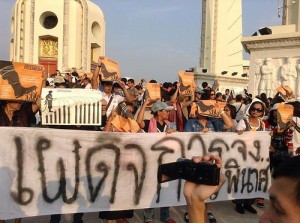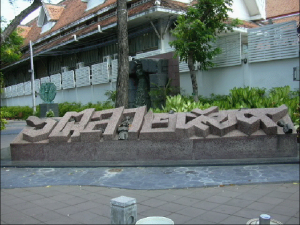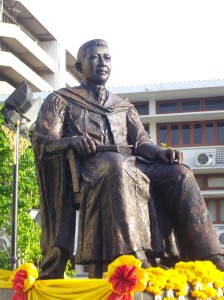Giles Ji Ungpakorn
Many historians have described the importance of monuments in modern day to day political struggles. This is part of what Gramsci would have called “the War of Position”. It is an ideological war between different sides or classes. The recent disappearance of the metal plaque celebrating the 1932 revolution against the king is part of this war.
The plaque was removed in secret sometime in April this year and replaced with what can only be described as a ridiculous right-wing pro-monarchist “drain cover”.
The fact that the monument was removed, while leading members of the junta and various authorities all deny knowledge or responsibility, raises some interesting questions. Those who have questioned the whereabouts of the plaque have also been detained by the military for “attitude changing sessions”.
A study of the works of Thai historians shows that the Democracy Monument, in the centre of Bangkok, is also part of the continuing Monument War. The Democracy Monument was in fact built by the military dictator Pibun in the 1930s as an anti-royalist monument. Pibun was a nationalist republican who favoured dictatorship over democracy. The monument was built in the middle of the “King’s Avenue”, a bit like giving the “middle finger” to the monarchy. It is worth visiting this monument to look at the modernist imagery which does not contain a single reference to the monarchy.
Pibun also built a huge nationalistic monument in Ayuttaya in the shape of the old provincial administration centre and the clumsy “restoration” of three pagodas. The old provincial administration centre has statues of past kings, much like the king statues built by the Burmese junta or statues of past kings built by modern day despots in former Soviet republics. Neither Pibun nor the Burmese junta nor the despots of former Soviet republics wanted a return to the days of monarchy.
The Democracy Monument in Bangkok is interesting because it shows that through popular struggle the meaning of monuments can change. Ever since the days of the royalist dictator Sarit, who overthrew Pibun, Thai citizens have seen this monument as a symbol of democracy. No dictatorship has ever dared to demolish it because of the strength of the democratic ideology among Thai people. In fact all these dictatorships, including the present Prayut junta, have all had to claim that they are “democratic”. None have dared to openly celebrate dictatorship over democracy.
When Sarit came to power, he promoted King Pumipon in order to give himself more legitimacy and power. He never had any intention of giving Pumipon any power and Pumipon was never powerful. We need to remember that “political power” is concrete. It determines social and economic policies and international relations. Neither Pumipon nor his idiot son have or have ever had this kind of power.

The 1932 revolution plaque was and still remains an anti-monarchy symbol, like the monument at Lak-Si, north of Bangkok, which commemorates the military victory against the royalist rebellion just after the revolution. At one time Sarit ordered the removal of the 1932 plaque, but it was returned to its original setting after his death. However, the conservatives have also tried to cover up and dismiss the history of the 1932 revolution. That is why most Thais probably have never heard of the 1932 plaque or the Lak-Si monument. That is also why the conservatives built the moment of the deposed king Rama 7 in front of the present parliament after the 6th October bloodbath in 1976. It is like building a monument to King George in front of the US Congress!
In this Monument War, the progressives fought back by building monuments to those who were killed by the military in 1973 and 1976. The latter monument is inside Thammasart University, which is also the location for a monument to Pridi Panomyong, founder of the People’s Party and a key leader of the 1932 revolution.
There are the usual conspiracy theorists who make up ridiculous stories about how King Wachiralongkorn ordered the removal of the 1932 revolution plaque. It is likely that the intellectually challenged new king was not aware until recently of the existence of this plaque.
Now a member of a strange right-wing sect called the “Smarn Si Ngarm Group” has claimed responsibility for removing the plaque. We shall have to see whether this is true or not. The “Smarn Si Ngarm Group” evolved from an earlier group set up by Communist Party turn-coat Prasert Supsuntorn. Prasert Supsuntorn joined with the military in opposing the CPT’s armed struggle. He then became a royalist. He and Smarn Si Ngarm use the language of the Left to promote pro-military ideology and royalism. Using secret funds from the military, they tried to spread their ideas among trade unionists and other political activists. They even provided some generals like Chawalit Yongjaiyut with “political education”.
But more importantly, we must not forget that for ten years now, the royalist anti-democrats have acted to destroy the democratic system and invite the military to take power. They acted on their own initiative, but the military was happy for the excuse to stage two coups. These fanatical royalist also threatened to take away the 1932 revolution plaque, especially after pro-democracy activists started to hold small ceremonies around the plaque coinciding with an increasing republican political mood in society. This is truly a “Monument War” in the War of Position.






